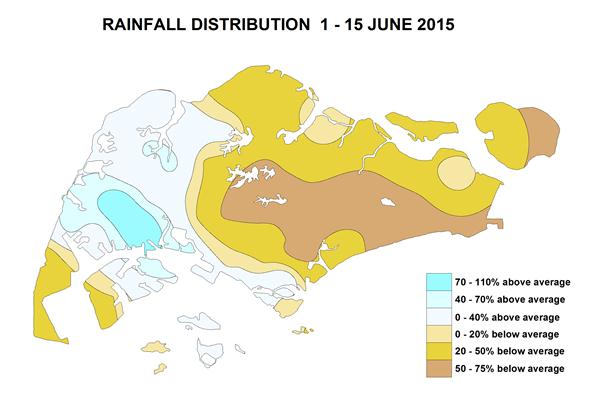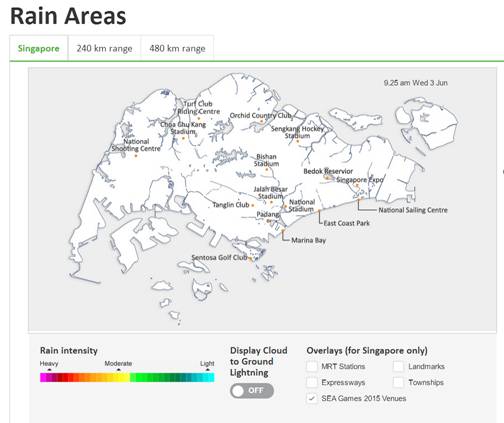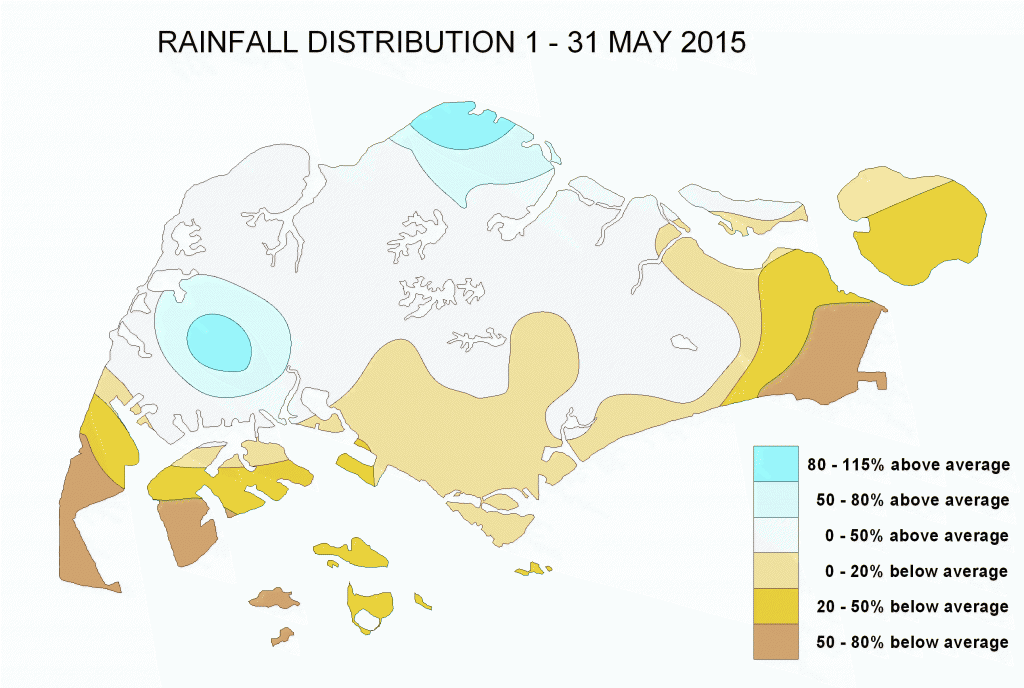Increased risk of hotspot activity and transboundary haze
Singapore, 26 June 2015 – Meteorological Service Singapore (MSS) is forecasting that Singapore and the surrounding region can expect a drier and warmer than usual Southwest Monsoon season[1] (June – September/early October) this year. This is partly due to the prevailing moderate El Niño[2] conditions in the equatorial Pacific Ocean, which are likely to further develop in the months ahead.
2 With fewer rain days experienced this month, the total rainfall for June 2015 (as at 25 June 2015) recorded at the Changi climate station is 38% below the long-term average. Warmer days and nights have also been experienced in recent days. The average daily maximum and minimum temperatures for June 2015 (as at 25 June 2015) are 31.9°C and 26.5°C, about 0.6°C and 1.7°C above the long-term average respectively .
3 Lower than usual rainfall is expected to persist for Singapore in the next few months. For July 2015 the total monthly rainfall is forecast to be 15-45% below average. The long-term rainfall and temperature statistics for July to September at the Changi climate station are shown in Table 1.
| July | August | September | |
| Average Monthly Rainfall Total (mm) | 158.6 | 175.4 | 168.8 |
| Average Daily Maximum Temperature (°C) | 30.9 | 30.9 | 30.9 |
| Average Daily Minimum Temperature (°C) | 24.6 | 24.5 | 24.3 |
Table 1: Long-term temperature and rainfall statistics for July-September
Impact of El Niño on Singapore
4 Most models from the major global climate centres project a high likelihood that the tropical Pacific sea surface temperatures would continue to warm over the coming months and possibly reach strong El Niño levels. During the 1997 El Niño which is the strongest on record, Singapore experienced a sharp 53% reduction in June-September rainfall. In the last occurrence of a moderate El Niño in 2009, Singapore’s rainfall total over the June-September period was about 20% below the long-term average. The average daily temperature for the same period in 2009 was 1.1°C higher than the long-term average of 27.4°C. The relationship between the strength of the El Niño and the impact on rainfall is however not straightforward, as there are also other factors affecting local and regional rainfall patterns.
Risk of Transboundary Haze
5 With the drier and warmer weather over the southern ASEAN region in the coming months, exacerbated by the prevailing El Niño, we may see an escalation of hotspot activities, particularly in the fire prone provinces in Sumatra and Kalimantan. This would increase the risk of occurrence of transboundary haze in the region. The impact of the smoke haze on Singapore is dependent on factors such as the proximity and extent of the fires, the strength and direction of the prevailing winds, and the incidence and amount of rain.
6 In recent days, sporadic hotspot activities with localised smoke plumes have been observed in Sumatra. In addition, drier and warmer weather conditions have prevailed over Singapore and the surrounding region, indicating the start of the traditional dry season in the southern ASEAN region.
7 MSS will continue to closely monitor the regional weather and haze situation as well as the development of the El Niño, and provide updates when necessary. Updates on haze information and the El Niño are available in the MSS website at
Haze Preparedness
8 In anticipation of the onset of drier weather, the Inter-Agency Haze Task Force (HTF) is co-ordinating the agencies’ respective action plans in preparation for haze. NEA’s haze forecasts and advisories will take into account the Ministry of Health (MOH)’s health advisories and Ministry of Manpower (MOM)’s workplace guidelines. The public can access NEA’s advisories at the NEA website (www.nea.gov.sg), the haze microsite (www.haze.gov.sg), or follow NEA on NEA Facebook (www.facebook.com/NEASingapore) and NEA Twitter (@NEAsg).
PUB’s preparedness
9 Drier weather and lower rainfall will affect reservoir stock levels. To prepare for the drier months ahead, PUB strongly urges the community and businesses to continue to conserve precious water.
~End~
[1] Southwest Monsoon season is characterised by prevailing winds that blow predominately from the southeast or southwest. The Southwest Monsoon months are generally the drier months of the year.
[2] The El Niño is known to disrupt normal weather patterns around the world, and in the ASEAN region, the El Niño could lead to prolonged drier and warmer weather over large parts of Southeast Asia. Singapore would normally experience drier and warmer conditions during moderate to strong El Niño events, especially during the Southwest Monsoon period. At other times outside of these months, the impact of El Niño on local rainfall is not as significant.


